Ponte Vecchio: The Oldest Bridge in Florence Over the Arno River
Home » Ponte Vecchio

- Updated on
Oh, the Ponte Vecchio! This iconic old bridge in Florence, Italy, is so much more than just a crossing over the Arno River. It’s a charming, medieval treasure that’s been around since the 14th century, and it’s still buzzing with life today.
Picture this: tiny shops lining the bridge, each one bursting with local jewelry, art, and trinkets. It’s like stepping into a vibrant, open-air shopping mall suspended over the water! The stunning Palazzo Vecchio is at the heart of it all, offering a peek into Florence’s rich history.

And if you’re lucky enough to stroll along the bridge, be sure to spot the Vasari Corridor, the elevated passageway that connects the Palazzo Vecchio to the Pitti Palace.
It’s such a whimsical experience, where you’re walking through centuries of history with beautiful views around every corner. The Ponte Vecchio truly feels like a living museum!
Author

Welcome!
Welcome to Florence Awaits!
My name is Allie.
Italy is one of my favorite countries to visit in Europe, especially Florence!
I love everything the city has to offer. From the architecture to the most delicious food and wine, Florence has it all. So, come with me on this beautiful journey through Florence.
Allie
Best tours, tickets & activities:
Tickets to Ponte Vecchio > open 24 hours a day, with no entry fee.
Adress:
Ponte Vecchio, 50125 Firenze Fl, Italy
Transportation:
From Florence Santa Maria Novella Train Station (main station): Walking: 15 min.
Nearby:
Piazza della Signoria: 4 minute walk.
Basilica of Santo Spirito: 7 minute walk.
Pitti Palace & Boboli Gardens: 5 minute walk.
Palazzo Vecchio – 4 minute walk.
Uffizi Gallery – 3-minute walk.
Piazzale Michelangelo: 20 minute walk.
Recommended exploration time:
30 minutes is sufficient for:
– Strolling across the bridge
– Taking photos
– Browsing the jewelry shops
– Enjoying river views
Up to 1 hour if you:
– Visit during a quieter time
– Explore the bust of Benvenuto Cellini
– Pause at shops or grab a coffee or gelato nearby
– Walk along the Arno River
Nearby Sights (optional add-ons):
Uffizi: 1.5-2.5 hours
What to Do When You Visit the Ponte Vecchio
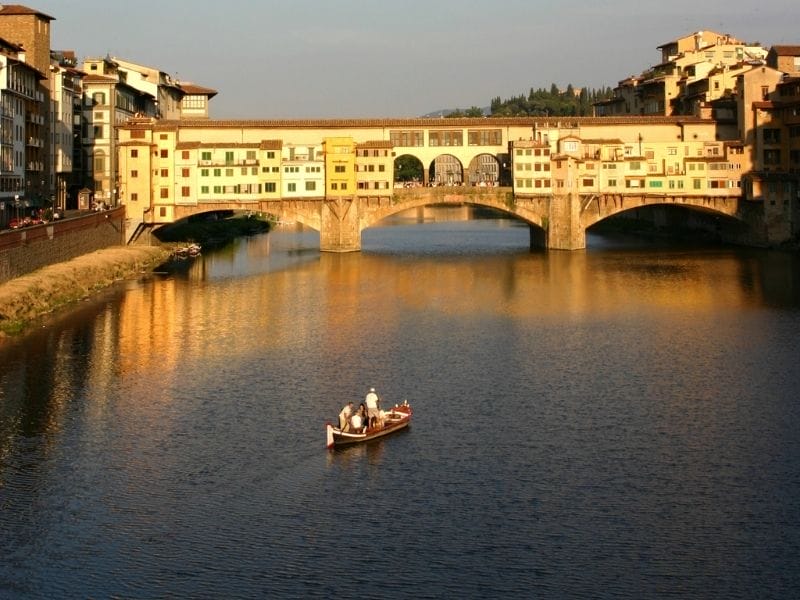
The Ponte Vecchio is a must-see when you visit Florence, and there are plenty of ways to enjoy it! Here’s a quick guide to making the most of your visit:
Take a Boat Trip on the Arno: For the best view of the Ponte Vecchio, hop on a boat trip on the Arno River. It’s a fun way to experience the bridge from a completely different angle and admire its medieval architecture from the water. Get tickets!
Explore the Jewellery Shops: The shops on the Ponte Vecchio are one of its most unique features. Whether you’re looking for a special souvenir or simply want to admire the fine jewelry shops, take your time to wander through these beautiful spaces.
Visit Nearby Landmarks: After you’ve explored the Ponte Vecchio, make sure to check out the Palazzo Pitti, the Uffizi gallery, and the rest of Florence’s historic city center. These landmarks are all within walking distance and offer more insight into the rich history of the city.
Take a Guided Tour: If you want to dive deeper into the history of the Ponte Vecchio, consider taking a guided tour. A knowledgeable guide can help bring the fascinating history of the bridge and the city to life and give you stories and facts you might miss on your own. Get tickets!
Catch a Sunset View: For a truly unforgettable experience, visit the Ponte Vecchio at sunset. The colors of the sky and the golden glow reflecting off the bridge will leave you in awe. It’s one of those moments that will stay with you forever.
What is the Ponte Vecchio?
The Ponte Vecchio is one of Florence’s most beloved landmarks and the oldest bridge in the city that crosses the Arno River. Ponte Vecchio is the only bridge in Florence to have survived World War II intact, a testament to its resilience and historical importance.
Ponte Vecchio was designed in 1345 by the Italian artist and architect Taddeo Gaddi. This bridge is a unique blend of history, architecture, and commerce. The most striking feature? The Ponte Vecchio is lined with little jewellery shops, making it a bustling center for goldsmiths and jewelers. It’s a place where you can stroll, shop for beautiful jewellery, and admire the lovely view of the Arno River flowing underneath.
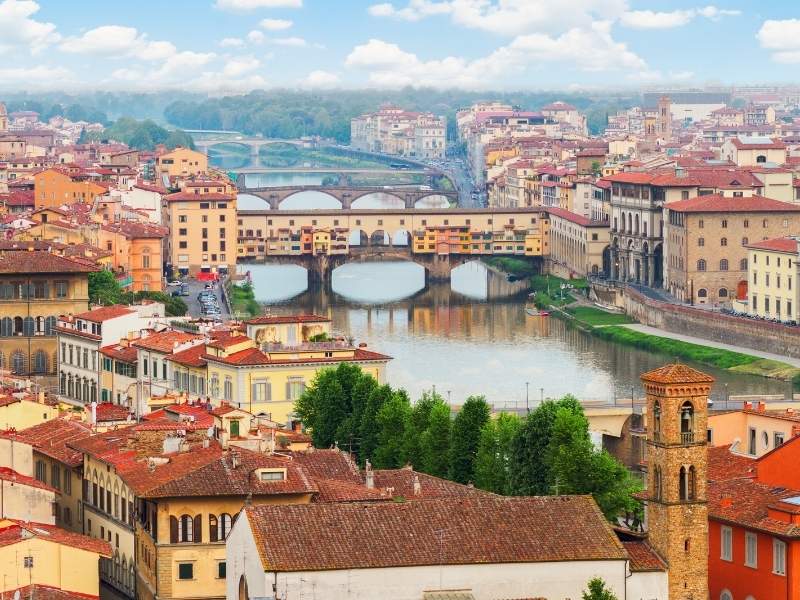
You might be wondering what makes this bridge so special, and I’ll tell you – it’s got so much personality! It’s not just a bridge for getting from one side of Florence to the other; it’s an experience in itself. The shops, with their colorful windows filled with sparkling jewellery, give the bridge a vivacious, almost magical atmosphere.
The Ponte Vecchio is a perfect example of how a bridge can be much more than just a functional piece of architecture. It is a focal point for the Florentine way of life and a must-see on any trip to Tuscany.
The Fascinating History of the Ponte Vecchio
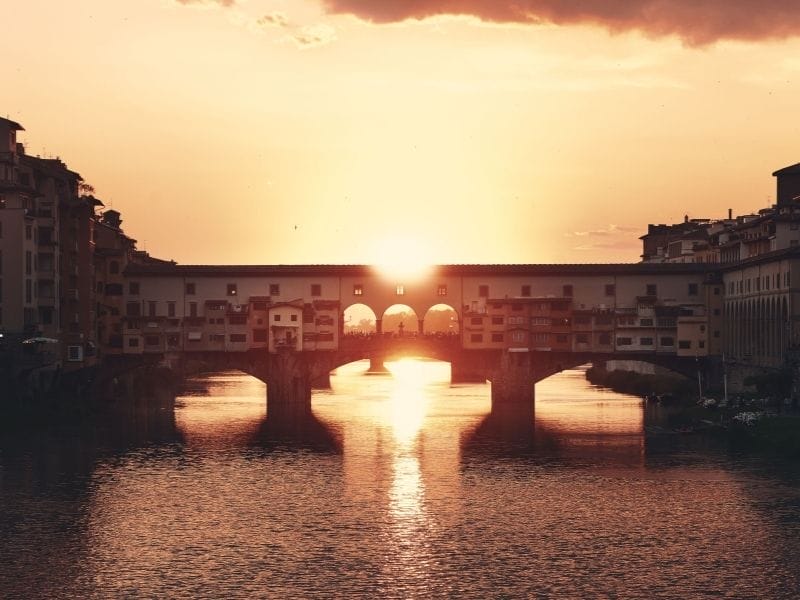
Now, let’s take a stroll back in time to explore the fascinating history behind the Ponte Vecchio. The bridge was originally a wooden structure in Roman times, but by 1345, it was replaced with the stone structure we see today. The Ponte Vecchio was designed by an architect named Taddeo Gaddi, who, interestingly, was an architect closely associated with the Medici family.
At first, the bridge featured shops where fishmongers and butchers would sell their goods. By 1565, the Medici family decided to rebuild the bridge’s purpose and transform it into a place for the city’s finest jewellers and goldsmiths.
The decision to allow jewelry shops to take over the bridge, and not butchers, came after an order from Francesco de’ Medici, who wanted to remove the unpleasant stench from the area. This decision would forever change the character of the Ponte Vecchio.
The bridge became more prominent as a commercial center, and the goldsmiths and jewelers began to dominate the Ponte Vecchio. It became a perfect blend of tradition and craftsmanship, making it one of the most iconic spots in Florence, Italy. The Ponte Vecchio became a symbol of the city, and even today, it’s filled with beautiful jewellery shops that draw visitors from all over the world.
In the late 16th century, Giorgio Vasari, an Italian artist and architect, created a secret elevated passageway called the Vasari Corridor, or Corridoio vasariano, which connected the Palazzo Pitti to the Uffizi.
This corridor allowed the ruling Medici family to walk privately between their residence and the government palace, away from the prying eyes of the public. Imagine strolling across the Ponte Vecchio, catching glimpses of the Vasari Corridor above you, and thinking about all the secret walks of the Medici family!
Surviving the Test of Time: The Ponte Vecchio During World War II
The Ponte Vecchio has weathered many challenges throughout its history, including the turbulence of World War II. In 1944, as the German army retreated from Florence, they prepared to destroy the city’s bridges to slow the Allied forces. However, in an incredible twist of fate, the German consul in Florence ordered the Ponte Vecchio to be spared from demolition.
The decision to spare this old bridge allowed it to remain a testament to the city’s heritage. It’s said that, rather than demolishing the Ponte Vecchio, the Germans destroyed all the surrounding bridges, but the Ponte Vecchio stood proudly. This moment of bravery preserved one of Florence’s most famous landmarks.
The 1966 Flood: A Tragedy and a Turning Point
In 1966, Florence faced one of its darkest moments: the disastrous flood that ravaged much of the city. The Arno River swelled to dangerous levels, burst its banks, and flooded the streets, causing irreparable damage. The Ponte Vecchio was miraculously spared from the worst of the damage, but many of the jewelry shops on the bridge were submerged, and precious antiques and works of art were lost.
While the Ponte Vecchio survived relatively unscathed, the flood was a heartbreaking moment in Florence’s history. However, it also marked a turning point in the city’s dedication to preserving its historic landmarks.
Restoration projects were launched, and the Ponte Vecchio—along with other historic structures—was carefully restored to its former glory. If you ever get a chance to take a boat trip on the Arno, you’ll get a unique view of the bridge from the water and feel its timeless beauty.
A View Like No Other: The Ponte Vecchio's Character
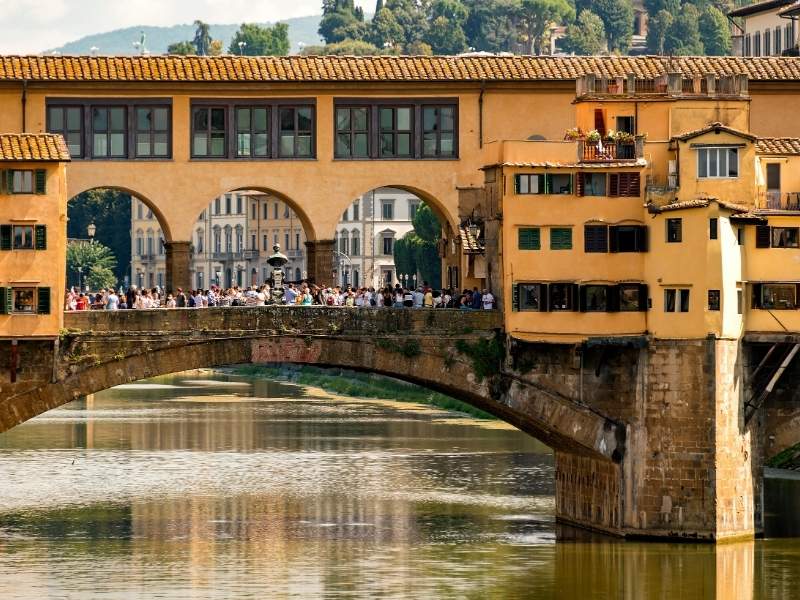
One of the best things about the Ponte Vecchio is the view! From the bridge, you get an incredible view of Ponte Vecchio with the Arno River flowing beneath, reflecting the colorful shops and buildings lining the sides.
The whole scene feels almost magical, like something straight out of a storybook. Whether you’re crossing the bridge or just stopping to take in the view, you’ll feel like you’re stepping into a painting.
On a trip to Florence, the Ponte Vecchio offers a direct view of the river as you gaze over the side of the bridge at the calm waters of the Arno. It’s one of the most romantic spots in the city—perfect for those looking to capture some of Florence’s magic on camera.
Why the Ponte Vecchio Is So Special
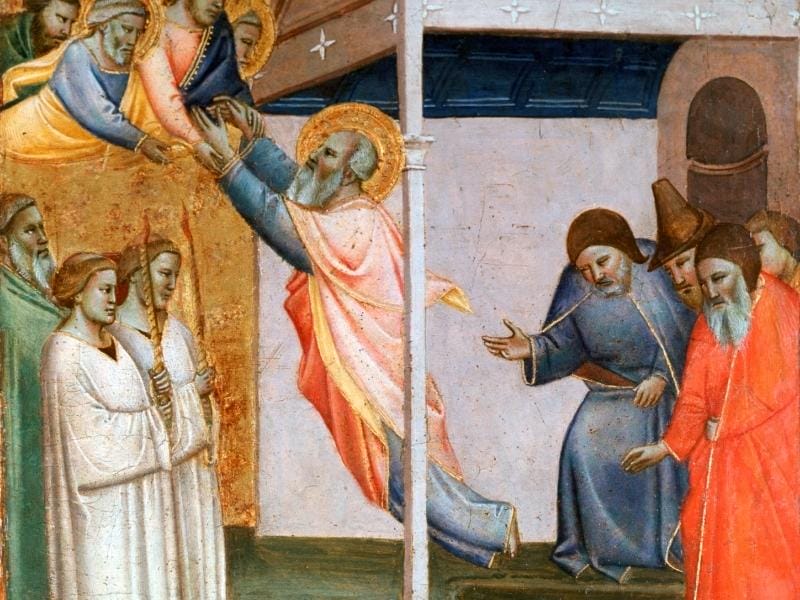
The Ponte Vecchio is more than just a bridge; it’s a symbol of Florence’s rich cultural heritage and its ability to stand the test of time. From its design by Taddeo Gaddi in 1345 to the historic moments it has survived, the Ponte Vecchio is a place that feels alive with history. Whether you’re there to shop for some beautiful jewellery or simply to take in the stunning views, this bridge will leave a lasting impression on you.
So next time you’re planning a visit to Florence, don’t forget to visit this famous bridge, where the past and present meet in the most delightful way. Whether you take a boat trip on the Arno or enjoy a casual stroll across its cobblestones, the Ponte Vecchio will surely steal your heart!
Practical Tips for Your Visit
Wear Comfortable Shoes: The bridge and surrounding streets are cobbled—great for photos, not for heels!
Best Photo Spots: For the most iconic shot of the bridge, head to Ponte Santa Trinita (3 min walk west). Sunset over the Arno River is especially photogenic.
Shop Smart: Jewelry prices can be steep due to the location. If you’re serious about buying, do a bit of price comparing beforehand.
Visit Early or Late: Mornings (before 9 a.m.) or evenings (after 7 p.m.) are less crowded and more romantic.
No Locking Love Locks: Attaching locks to the bridge railings is prohibited and often removed by city workers.
Safety: Be cautious of pickpockets, especially during peak tourist hours.
Tickets & Führungen
FAQ
Do I need a ticket to visit Ponte Vecchio?
No. The bridge is a public walkway and is completely free to visit.
Are there toilets on or near the bridge?
There are no toilets on the bridge. Public restrooms can be found at:
Piazza della Signoria (4 min walk)
Uffizi Gallery (if you’re visiting)
Is the bridge accessible for wheelchairs or strollers?
Yes. The surface is cobbled, but it is flat and accessible to wheelchairs and strollers. Just watch for foot traffic.
Can I drive or bike across Ponte Vecchio?
No. It is pedestrian-only. Bicycles must be walked across.
Is it safe at night?
Yes, Ponte Vecchio is generally safe at night thanks to regular foot traffic and lighting. Still, stay alert for pickpockets.
Is the Vasari Corridor open to the public?
Yes! After years of restoration, the Vasari Corridor reopened in 2024 for guided visits. You’ll need a separate ticket (usually through the Uffizi Gallery).
Be sure to also check out:
